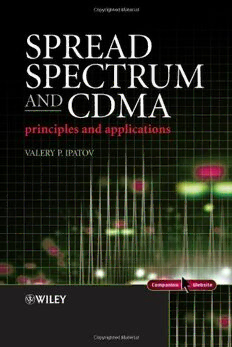
Spread Spectrum and CDMA: Principles and Applications PDF
398 Pages·2005·3.298 MB·English
Most books are stored in the elastic cloud where traffic is expensive. For this reason, we have a limit on daily download.
Preview Spread Spectrum and CDMA: Principles and Applications
Description:
Spread spectrum and CDMA are cutting-edge technologies widely used in operational radar, navigation and telecommunication systems and play a pivotal role in the development of the forthcoming generations of systems and networks.This comprehensive resource presents the spread spectrum concept as a product of the advancements in wireless IT, shows how and when the classical problems of signal transmission/processing stimulate the application of spread spectrum, and clarifies the advantages of spread spectrum philosophy. Detailed coverage is provided of the tools and instruments for designing spread spectrum and CDMA signals answering why a designer will prefer one solution over another. The approach adopted is wide-ranging, covering issues that apply to both data transmission and data collection systems such as telecommunications, radar, and navigation.Presents a theory-based analysis complemented by practical examples and real world case studies resulting in a self-sufficient treatment of the subjectContains detailed discussions of new trends in spread spectrum technology such as multi-user reception, multicarrier modulation, OFDM, MIMO and space-time codingProvides advice on designing discrete spread spectrum signals and signal sets for time-frequency measuring, synchronization and multi-user communicationsFeatures numerous Matlab-based problems and other exercises to encourage the reader to initiate independent investigations and simulationsThis valuable text provides timely guidance on the current status and future potential of spread spectrum and CDMA and is an invaluable resource for senior undergraduates and postgraduate students, lecturers and practising engineers and researchers involved in the deployment and development of spread spectrum and CDMA technology.Supported by a Companion website on which instructors and lecturers can find a solutions manual for the problems and Matlab programming, electronic versions of some of the figures and other useful resources such as a list of abbreviations.
See more
The list of books you might like
Most books are stored in the elastic cloud where traffic is expensive. For this reason, we have a limit on daily download.
